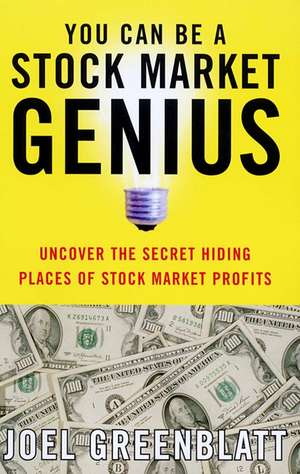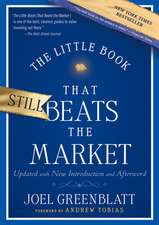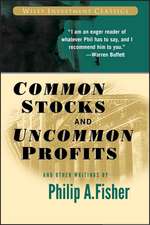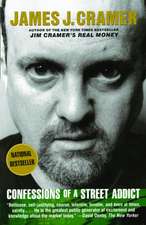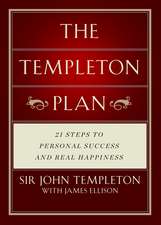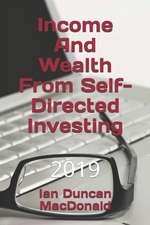You Can Be a Stock Market Genius: Uncover the Secret Hiding Places of Stock Market Profits
Autor Joel Greenblatten Limba Engleză Paperback – 16 iun 2008
Fund manager Joel Greenblatt has been beating the Dow (with returns of 50 percent a year) for more than a decade. And now, in this highly accessible guide, he’s going to show you how to do it, too. You’re about to discover investment opportunities that portfolio managers, business-school professors, and top investment experts regularly miss—uncharted areas where the individual investor has a huge advantage over the Wall Street wizards. Here is your personal treasure map to special situations in which big profits are possible, including:
-Spin-offs
-Restructurings
-Merger Securities
-Rights Offerings
-Recapitalizations
-Bankruptcies
-Risk Arbitrage
Prepared with the tools from this guide, it won’t be long until you’re a stock market genius!
Preț: 116.94 lei
Nou
Puncte Express: 175
Preț estimativ în valută:
22.38€ • 23.07$ • 18.90£
22.38€ • 23.07$ • 18.90£
Carte disponibilă
Livrare economică 11-25 februarie
Livrare express 25-31 ianuarie pentru 40.82 lei
Preluare comenzi: 021 569.72.76
Specificații
ISBN-13: 9780684840079
ISBN-10: 0684840073
Pagini: 304
Dimensiuni: 140 x 214 x 25 mm
Greutate: 0.28 kg
Editura: Touchstone Publishing
Colecția Touchstone
ISBN-10: 0684840073
Pagini: 304
Dimensiuni: 140 x 214 x 25 mm
Greutate: 0.28 kg
Editura: Touchstone Publishing
Colecția Touchstone
Notă biografică
Joel Greenblatt is the founder and a managing partner of Gotham Capital, a private investment partnership that has achieved 40% annualized returns since its inception in 1985. He is a professor on the adjunct faculty of Columbia Business School, the former chairman of the board of a Fortune 500 company, the cofounder of ValueInvestorsClub.com, and the author of several books, including You Can Be a Stock Market Genius, The Big Secret for the Small Investor, and Common Sense. Greenblatt holds a BS and an MBA from the Wharton School.
Extras
Chapter 1
Follow the Yellow Brick Road --
Then Hang a Right
It doesn't make sense that a book can teach you how to make a fortune in the stock market. After all, what chance do you have for success when you're up against an army of billion-dollar portfolio managers or a horde of freshly trained MBAs? A contest between you, the proud owner of a $24 "how to" book, and these guys hardly seems fair.
The truth is, it isn't fair. The well-heeled Wall Street money managers and the hotshot MBA's don't have a chance against you and this book. No, you won't find any magic formula in chapter 8, and this isn't a sequel to How to Succeed in Business Without Really Trying, but if you're willing to invest a reasonable amount of time and effort, stock market profits, and even a fortune, await.
Okay: What's the catch? If it's so easy, why can't the MBAs and the pros beat your pants off? Clearly, they put in their share of time and effort, find while they may not all be rocket scientists, there aren't many village idiots among them either.
As strange as it may seem, there is no catch. The answer to this apparent paradox -- why you potentially have the power to beat the pants off the so-called market "experts" -- lies in a study of academic thinking, the inner workings of Wall Street, and the weekend habits of my in-laws.
We start with some good news about your education: simply put, if your goal is to beat the market, an MBA or a Ph.D. from a top business school will be of virtually no help. Well, it's good news, that is, if you haven't yet squandered tons of time and money at a business school in the single-minded quest for stock market success. In fact, the basic premise of most academic theory is this: It is not possible to beat the market consistently other than by luck.
This theory, usually referred to as the efficient-market or "random-walk" theory, suggests that thousands of investors and analysts take in all the publicly available information on a particular company, and through their decisions to buy and sell that company's stock establish the "correct" trading price. In effect, since stocks are more or less efficiently priced (and therefore, you can't consistently find bargain-priced stocks), it is not possible to outperform the market averages over long periods of time. Although exceptions (e.g., the January effect, small size effects and low price/earnings strategies) are covered briefly by the academics, most of these "market-beating" strategies are dismissed as trivial, transient, or difficult to achieve after factoring in taxes and transaction costs.
Since beating the market is out of the question, finance professors spend a lot of time teaching things like quadratic parametric programming -- which, loosely translates to how to pick diversified stock portfolios in three-dimensional space. In other words, if you muddle through complex mathematical formulas and throw in a little calculus and statistical theory along the way, you stand a pretty good chance of matching the performance of the popular market averages. Wow! While there are plenty of other bells and whistles, the message is clear: You can't beat the market, so don't even try. Thousands of MBA's and Ph.D.'s have paid good money for this lousy advice.
There are two reasons not to accept the basic teachings of the professors. First, there are some fundamental flaws in the assumptions and methodology used by the academics -- flaws we'll look at briefly later on, but which are not the central focus of this book. Second, and more important, even if the professors are generally correct and the market for stocks is more or less efficient, their studies and conclusions do not apply to you.
Obviously, most of Wall Street must also ignore the academics because the whole concept of getting paid for your investment advice, whether through commissions or investment advisory fees, doesn't square too well with the idea that the advice really isn't worth anything. Unfortunately for the professionals, the facts would seem to support the conclusions of the academics. If academic theory held true, you would expect the long-term record of pension and mutual-fund managers to equal the performance of the market averages reduced by the amount of the advisory fee. In a slight deviation from efficient-market theory, the professionals actually do approximately 1 percent worse per year than the relevant market averages, even before deducting their management fees. Does the theory that markets are "more or less" efficient explain this disappointing performance on the part of professionals, or are there other factors at work that lead to these lackluster results?
The Professional's Challenge
I spoke with a professional whom I consider one of the best in the business, a friend I'll call Bob (even though his real name is Rich). Bob is in charge of $12 billion of U.S. equity funds at a major investment firm. For some perspective, if you went to the racetrack and placed a bet with $100 bills, $12 billion would stack twenty World Trade Centers high (needless to say, a bet that would almost certainly kill the odds on your horse). According to Bob, the bottom line and the measure of his success is this: How does the return on his portfolio stack up against the return of the Standard & Poor's 500 average? In fact, Bob's record is phenomenal: over the past ten years his average annual return has exceeded the return of the S&P 500 by between 2 and 3 percent.
At first blush, the word "phenomenal" and an increased annual yield of 2 or 3 percent seem somewhat incongruous. Though it is true that after twenty years of compounding even 2 percent extra per year creates a 50 percent larger nest egg, this is not why Bob's returns are phenomenal. Bob's performance is impressive because in the world of billion-dollar portfolios, this level of excess return is incredibly hard to come by on a consistent basis. Some quick calculations help expose the limitations imposed on Bob by the sheer size of his portfolio. Imagine the dollar investment in each stock position when Bob sets out to divvy up $12 billion. To create a 50-stock portfolio, the average investment in each individual stock would have to be approximately $240 million; for 100 stocks, $120 million.
There are approximately 9,000 stocks listed on the New York Stock Exchange, the American Stock Exchange, and the NASDAQ over-the-counter market combined. Of this number, about 800 stocks have a market capitalization over $2.5 billion and approximately 1,500 have market values over $1 billion. If we assume Bob does not care to own more than 10 percent of any company's outstanding shares (for legal and liquidity reasons), it's likely that the minimum number of different stocks Bob will end up with in his portfolio will fall somewhere between 50 and 100. If he chooses to expand the universe from which he chooses potential purchase candidates to those companies with market capitalizations below $1 billion, perhaps to take advantage of some lesser followed and possibly undiscovered bargain stocks, his minimum number could easily expand to over 200 different stocks.
Intuitively, you would probably agree that there is an advantage to holding a diversified portfolio so that one or two unfortunate (read "bonehead") stock picks do not unduly impair your confidence and pocketbook. On the other hand, is the correct number of different stocks to own in a "properly" diversified portfolio 50, 100, or even 200?
It turns out that diversification addresses only a portion (and not the major portion) of the overall risk of investing in the stock market. Even if you took the precaution of owning 9,000 stocks, you would still be at risk for the up and down movement of the entire market. This risk, known as market risk, would not have been eliminated by your "perfect" diversification.
While simply buying more stocks can't help you avoid market risk, it can help you avoid another kind of risk -- "nonmarket risk." Nonmarket risk is the portion of a stock's risk that is not related to the stock market's overall movements. This type of risk can arise when a company's factory burns down or when a new product doesn't sell as well as expected. By not placing all your eggs in a buggy-whip, breast-implant, pet-rock, or huckapoo-sweater company, you can diversify away that portion of your risk that comes from the misfortunes of any individual company.
Statistics say that owning just two stocks eliminates 46 percent of the nonmarket risk of owning just one stock. This type of risk is supposedly reduced by 72 percent with a four-stock portfolio, by 81 percent with eight stocks, 93 percent with 16 stocks, 96 percent with 32 stocks, and 99 percent with 500 stocks. Without quibbling over the accuracy of these particular statistics, two things should be remembered:
1. After purchasing six or eight stocks in different industries, the benefit of adding even more stocks to your portfolio in an effort to decrease risk is small, and
2. Overall market risk will not be eliminated merely by adding more stocks to your portfolio.
From a practical standpoint, when Bob chooses his favorite stocks and is on pick number twenty, thirty, or eighty, he is pursuing a strategy imposed on him by the dollar size of his portfolio, legal issues, and fiduciary considerations, not because he feels his last picks are as good as his first or because he needs to own all those stocks for optimum portfolio diversification.
In short, poor Bob has to come up with scores of great stock ideas, choose from a limited universe of the most widely followed stocks, buy and sell large amounts of individual stocks without affecting their share prices, and perform in a fish bowl where his returns are judged quarterly and even monthly.
Luckily, you don't.
The Secret To Your Fortune
Since Bob clearly has his hands full, where can an investor turn for insight into making a fortune in the stock market? For better or worse, all roads appear to leave us at the doorstep of my in-laws. (Don't worry, I said mine -- not yours.)
A typical weekend will find them scouting out a country auction, antique store, or estate sale looking for art or antiques that catch their fancy. As avid collectors, they seek out works that will give them joy to own and live with on a daily basis. As closet capitalists, they look for undiscovered or unrecognized works of art or antiques that they can buy at prices far below true value.
When in capitalist mode, the in-laws follow a very simple strategy. Whether they find a beautiful specimen of antique furniture at Podunk Fine Antiques & Tractor Parts or an impressionist painting from Grandma Bagodonuts' attic, they ask themselves only one question before buying. Are there comparable pieces of furniture or paintings that have recently sold at auction (or to dealers) at prices far above the potential purchase price?
It's truly that simple, although we can probably learn more from the questions they don't ask. They don't ask, "Is this painter going to be the next Picasso?" or "Is eighteenth-century French furniture going to skyrocket in value?" While it would be nice and perhaps more lucrative to be able to predict those types of future developments, few people can combine the ability, knowledge, and timing to foresee and profit consistently from future events. Whether the in-laws can or cannot predict the future is beside the point; they don't have to -- they already know how to profit from studying the present.
That doesn't mean their knowledge of art and antiques doesn't help them to make money, but many people can acquire that same knowledge. Their edge comes from taking this knowledge and applying it in places off the beaten path. While these places are tougher to find, once found, less competition from other informed collectors creates an opportunity for them to find "inefficiently" priced bargains.
Finding bargain stocks works much the same way. If you spend your energies looking for and analyzing situations not closely followed by other informed investors, your chance of finding bargains greatly increases. The trick is locating those opportunities.
It's like the old story about the plumber who comes to your house, bangs on the pipes once, and says, "That'll be a hundred dollars."
"A hundred dollars!" you say. "All you did was bang on the pipes once!"
"Oh no," the plumber responds. "Banging on the pipes is only five dollars. Knowing where to bang -- that's ninety-five dollars."
In the stock market, knowing where to "bang" is the secret to your fortune. With that in mind, let's uncover some of the secret hiding places of stock-market profits.
Copyright © 1997 by Joel Greenblatt
Follow the Yellow Brick Road --
Then Hang a Right
It doesn't make sense that a book can teach you how to make a fortune in the stock market. After all, what chance do you have for success when you're up against an army of billion-dollar portfolio managers or a horde of freshly trained MBAs? A contest between you, the proud owner of a $24 "how to" book, and these guys hardly seems fair.
The truth is, it isn't fair. The well-heeled Wall Street money managers and the hotshot MBA's don't have a chance against you and this book. No, you won't find any magic formula in chapter 8, and this isn't a sequel to How to Succeed in Business Without Really Trying, but if you're willing to invest a reasonable amount of time and effort, stock market profits, and even a fortune, await.
Okay: What's the catch? If it's so easy, why can't the MBAs and the pros beat your pants off? Clearly, they put in their share of time and effort, find while they may not all be rocket scientists, there aren't many village idiots among them either.
As strange as it may seem, there is no catch. The answer to this apparent paradox -- why you potentially have the power to beat the pants off the so-called market "experts" -- lies in a study of academic thinking, the inner workings of Wall Street, and the weekend habits of my in-laws.
We start with some good news about your education: simply put, if your goal is to beat the market, an MBA or a Ph.D. from a top business school will be of virtually no help. Well, it's good news, that is, if you haven't yet squandered tons of time and money at a business school in the single-minded quest for stock market success. In fact, the basic premise of most academic theory is this: It is not possible to beat the market consistently other than by luck.
This theory, usually referred to as the efficient-market or "random-walk" theory, suggests that thousands of investors and analysts take in all the publicly available information on a particular company, and through their decisions to buy and sell that company's stock establish the "correct" trading price. In effect, since stocks are more or less efficiently priced (and therefore, you can't consistently find bargain-priced stocks), it is not possible to outperform the market averages over long periods of time. Although exceptions (e.g., the January effect, small size effects and low price/earnings strategies) are covered briefly by the academics, most of these "market-beating" strategies are dismissed as trivial, transient, or difficult to achieve after factoring in taxes and transaction costs.
Since beating the market is out of the question, finance professors spend a lot of time teaching things like quadratic parametric programming -- which, loosely translates to how to pick diversified stock portfolios in three-dimensional space. In other words, if you muddle through complex mathematical formulas and throw in a little calculus and statistical theory along the way, you stand a pretty good chance of matching the performance of the popular market averages. Wow! While there are plenty of other bells and whistles, the message is clear: You can't beat the market, so don't even try. Thousands of MBA's and Ph.D.'s have paid good money for this lousy advice.
There are two reasons not to accept the basic teachings of the professors. First, there are some fundamental flaws in the assumptions and methodology used by the academics -- flaws we'll look at briefly later on, but which are not the central focus of this book. Second, and more important, even if the professors are generally correct and the market for stocks is more or less efficient, their studies and conclusions do not apply to you.
Obviously, most of Wall Street must also ignore the academics because the whole concept of getting paid for your investment advice, whether through commissions or investment advisory fees, doesn't square too well with the idea that the advice really isn't worth anything. Unfortunately for the professionals, the facts would seem to support the conclusions of the academics. If academic theory held true, you would expect the long-term record of pension and mutual-fund managers to equal the performance of the market averages reduced by the amount of the advisory fee. In a slight deviation from efficient-market theory, the professionals actually do approximately 1 percent worse per year than the relevant market averages, even before deducting their management fees. Does the theory that markets are "more or less" efficient explain this disappointing performance on the part of professionals, or are there other factors at work that lead to these lackluster results?
The Professional's Challenge
I spoke with a professional whom I consider one of the best in the business, a friend I'll call Bob (even though his real name is Rich). Bob is in charge of $12 billion of U.S. equity funds at a major investment firm. For some perspective, if you went to the racetrack and placed a bet with $100 bills, $12 billion would stack twenty World Trade Centers high (needless to say, a bet that would almost certainly kill the odds on your horse). According to Bob, the bottom line and the measure of his success is this: How does the return on his portfolio stack up against the return of the Standard & Poor's 500 average? In fact, Bob's record is phenomenal: over the past ten years his average annual return has exceeded the return of the S&P 500 by between 2 and 3 percent.
At first blush, the word "phenomenal" and an increased annual yield of 2 or 3 percent seem somewhat incongruous. Though it is true that after twenty years of compounding even 2 percent extra per year creates a 50 percent larger nest egg, this is not why Bob's returns are phenomenal. Bob's performance is impressive because in the world of billion-dollar portfolios, this level of excess return is incredibly hard to come by on a consistent basis. Some quick calculations help expose the limitations imposed on Bob by the sheer size of his portfolio. Imagine the dollar investment in each stock position when Bob sets out to divvy up $12 billion. To create a 50-stock portfolio, the average investment in each individual stock would have to be approximately $240 million; for 100 stocks, $120 million.
There are approximately 9,000 stocks listed on the New York Stock Exchange, the American Stock Exchange, and the NASDAQ over-the-counter market combined. Of this number, about 800 stocks have a market capitalization over $2.5 billion and approximately 1,500 have market values over $1 billion. If we assume Bob does not care to own more than 10 percent of any company's outstanding shares (for legal and liquidity reasons), it's likely that the minimum number of different stocks Bob will end up with in his portfolio will fall somewhere between 50 and 100. If he chooses to expand the universe from which he chooses potential purchase candidates to those companies with market capitalizations below $1 billion, perhaps to take advantage of some lesser followed and possibly undiscovered bargain stocks, his minimum number could easily expand to over 200 different stocks.
Intuitively, you would probably agree that there is an advantage to holding a diversified portfolio so that one or two unfortunate (read "bonehead") stock picks do not unduly impair your confidence and pocketbook. On the other hand, is the correct number of different stocks to own in a "properly" diversified portfolio 50, 100, or even 200?
It turns out that diversification addresses only a portion (and not the major portion) of the overall risk of investing in the stock market. Even if you took the precaution of owning 9,000 stocks, you would still be at risk for the up and down movement of the entire market. This risk, known as market risk, would not have been eliminated by your "perfect" diversification.
While simply buying more stocks can't help you avoid market risk, it can help you avoid another kind of risk -- "nonmarket risk." Nonmarket risk is the portion of a stock's risk that is not related to the stock market's overall movements. This type of risk can arise when a company's factory burns down or when a new product doesn't sell as well as expected. By not placing all your eggs in a buggy-whip, breast-implant, pet-rock, or huckapoo-sweater company, you can diversify away that portion of your risk that comes from the misfortunes of any individual company.
Statistics say that owning just two stocks eliminates 46 percent of the nonmarket risk of owning just one stock. This type of risk is supposedly reduced by 72 percent with a four-stock portfolio, by 81 percent with eight stocks, 93 percent with 16 stocks, 96 percent with 32 stocks, and 99 percent with 500 stocks. Without quibbling over the accuracy of these particular statistics, two things should be remembered:
1. After purchasing six or eight stocks in different industries, the benefit of adding even more stocks to your portfolio in an effort to decrease risk is small, and
2. Overall market risk will not be eliminated merely by adding more stocks to your portfolio.
From a practical standpoint, when Bob chooses his favorite stocks and is on pick number twenty, thirty, or eighty, he is pursuing a strategy imposed on him by the dollar size of his portfolio, legal issues, and fiduciary considerations, not because he feels his last picks are as good as his first or because he needs to own all those stocks for optimum portfolio diversification.
In short, poor Bob has to come up with scores of great stock ideas, choose from a limited universe of the most widely followed stocks, buy and sell large amounts of individual stocks without affecting their share prices, and perform in a fish bowl where his returns are judged quarterly and even monthly.
Luckily, you don't.
The Secret To Your Fortune
Since Bob clearly has his hands full, where can an investor turn for insight into making a fortune in the stock market? For better or worse, all roads appear to leave us at the doorstep of my in-laws. (Don't worry, I said mine -- not yours.)
A typical weekend will find them scouting out a country auction, antique store, or estate sale looking for art or antiques that catch their fancy. As avid collectors, they seek out works that will give them joy to own and live with on a daily basis. As closet capitalists, they look for undiscovered or unrecognized works of art or antiques that they can buy at prices far below true value.
When in capitalist mode, the in-laws follow a very simple strategy. Whether they find a beautiful specimen of antique furniture at Podunk Fine Antiques & Tractor Parts or an impressionist painting from Grandma Bagodonuts' attic, they ask themselves only one question before buying. Are there comparable pieces of furniture or paintings that have recently sold at auction (or to dealers) at prices far above the potential purchase price?
It's truly that simple, although we can probably learn more from the questions they don't ask. They don't ask, "Is this painter going to be the next Picasso?" or "Is eighteenth-century French furniture going to skyrocket in value?" While it would be nice and perhaps more lucrative to be able to predict those types of future developments, few people can combine the ability, knowledge, and timing to foresee and profit consistently from future events. Whether the in-laws can or cannot predict the future is beside the point; they don't have to -- they already know how to profit from studying the present.
That doesn't mean their knowledge of art and antiques doesn't help them to make money, but many people can acquire that same knowledge. Their edge comes from taking this knowledge and applying it in places off the beaten path. While these places are tougher to find, once found, less competition from other informed collectors creates an opportunity for them to find "inefficiently" priced bargains.
Finding bargain stocks works much the same way. If you spend your energies looking for and analyzing situations not closely followed by other informed investors, your chance of finding bargains greatly increases. The trick is locating those opportunities.
It's like the old story about the plumber who comes to your house, bangs on the pipes once, and says, "That'll be a hundred dollars."
"A hundred dollars!" you say. "All you did was bang on the pipes once!"
"Oh no," the plumber responds. "Banging on the pipes is only five dollars. Knowing where to bang -- that's ninety-five dollars."
In the stock market, knowing where to "bang" is the secret to your fortune. With that in mind, let's uncover some of the secret hiding places of stock-market profits.
Copyright © 1997 by Joel Greenblatt
Cuprins
Contents
1. Follow the Yellow Brick Road -- Then Hang a Right
2. Some Basics -- Don't Leave Home Without Them
3. Chips Off the Old Stock: Spinoffs, Partial Spinoffs, and Rights Offerings
4. Don't Try This at Home: Risk Arbitrage and Merger Securities
5. Blood in the Streets (Hopefully, Not Yours): Bankruptcy and Restructuring
6. "Baby Needs New Shoes" Meets "Other People's Money": Recapitalizations and Stub Stocks, LEAPS, Warrants, and Options
7. Seeing the Trees Through the Forest
8. All the Fun's in Getting There
Appendix: Gotham Capital
Glossary
Index
1. Follow the Yellow Brick Road -- Then Hang a Right
2. Some Basics -- Don't Leave Home Without Them
3. Chips Off the Old Stock: Spinoffs, Partial Spinoffs, and Rights Offerings
4. Don't Try This at Home: Risk Arbitrage and Merger Securities
5. Blood in the Streets (Hopefully, Not Yours): Bankruptcy and Restructuring
6. "Baby Needs New Shoes" Meets "Other People's Money": Recapitalizations and Stub Stocks, LEAPS, Warrants, and Options
7. Seeing the Trees Through the Forest
8. All the Fun's in Getting There
Appendix: Gotham Capital
Glossary
Index
Recenzii
The Wall Street Journal Joel Greenblatt can indeed teach you about the market and how fortunes can be made there.
Andrew Tobias bestselling author of The Only Investment Guide You'll Ever Need I hope few investors will read this smart, sophisticated, fun book. I don't want competition profiting from its very real insights.
Alan C. "Ace" Greenburg Chairman of the Board, Bear Stearns Joel is my kind of guy -- very, very long on common sense. This book is great!
Andrew Tobias bestselling author of The Only Investment Guide You'll Ever Need I hope few investors will read this smart, sophisticated, fun book. I don't want competition profiting from its very real insights.
Alan C. "Ace" Greenburg Chairman of the Board, Bear Stearns Joel is my kind of guy -- very, very long on common sense. This book is great!
Descriere
This is a practical and easy-to-use investment reference, filled with case studies, important background information, and all the tools you'll need. All it takes is a little extra time and effort - and you can be a stock market genius.
